Dragon fruit is an exciting exotic fruit to grow in your home garden. And nothing beats the taste of your own homegrown fruit. This article provides a comprehensive guide on how to plant, care for, and harvest your own dragon fruit (also known as pitaya and strawberry pears). I provide all the steps you need to get started, so let’s dig in.
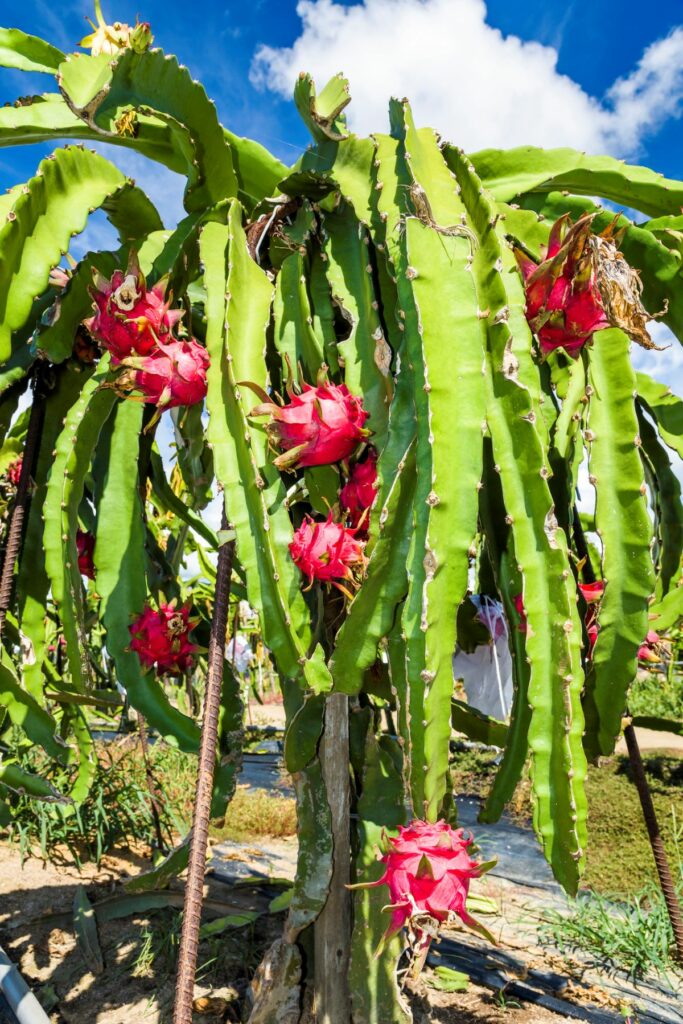
Related: Dragon Fruit: How To Eat it and What it Tastes Like
Table of Contents
Dragon Fruit Plant Size
As you plan your garden, you might be wondering how big dragon fruit grows. It’s a good question! And important to know so you can position your plant correctly in your space.
Dragon fruit plants (Selenicereus undatus) are vining cacti, and they can grow vertically by climbing a support structure. This assists their branches to hang downwards which is required to produce flowers and set fruit.
Dragon fruit trees can reach heights of 10 to 20 feet (3 to 6 meters) or even more if provided with adequate support.
The spread of a dragon fruit plant is typically as wide as the support structure it’s grown on. The branches can extend horizontally to create a bushy appearance. And the spread can be in the range of 5 to 10 feet (1.5 to 3 meters) or more.
When grown in pots or containers, dragon fruit plants tend to be more compact. In containers, they can reach heights of 6 to 8 feet (1.8 to 2.4 meters). The size may be limited by the size of the container but mature dragon fruit plants can be planted in 15-25 gallon (57-95 liter) containers.
The individual branches of a mature dragon fruit plant can reach around 3 to 5 feet (0.9 to 1.5 meters).
Planting out in the garden, you should allow about 8-13 feet (2.5-4 meters) between plants.
The great news is that you can control the size and shape of your dragon fruit plant through pruning and training.
Now that we know how big a dragon fruit plant grows, let’s find out its ideal growing conditions.
Dragon Fruit Plant Ideal Growing Conditions
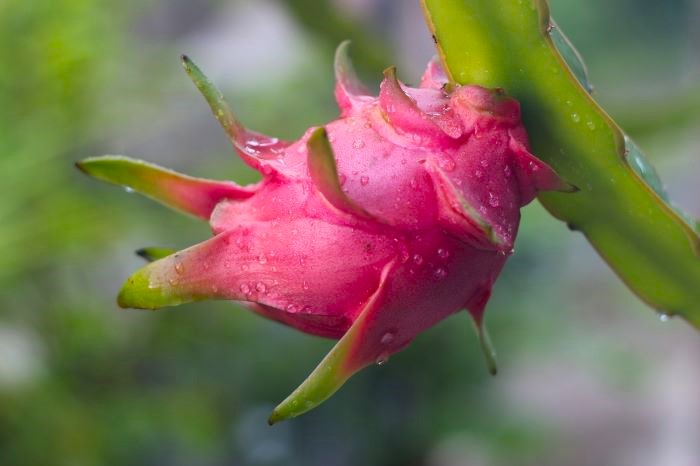
Dragon fruit is native to Central America with a long history of cultivation in these areas.
So if we keep that in mind, we can mimic the ideal environment where dragon fruit will grow successfully. That means we need to consider our climate, sun exposure, soil conditions, watering and fertilizing.
Climate
Dragon fruit is a tropical fruit and thrives in warm climates with high humidity. It requires temperatures between 65 to 85°F (18 to 29°C) for optimal growth.
It’s important to note that dragon fruit plants are sensitive to frost and cold temperatures, so they require protection or should be planted in areas where temperatures don’t drop significantly during the winter months.
If you live in a region with cold winters, it is best to grow dragon fruit in large pots or containers so you can move them indoors or in a greenhouse.
Sunlight
As a sun-loving plant, dragon fruit thrives in full sun of at least 6 to 8 hours of direct sunlight per day. Sunlight is essential for dragon fruit plants to produce fruit successfully. In fact, the more sun they receive, the better they tend to perform. This means they should be exposed to direct sunlight for the majority of daylight hours.
Dragon fruit can tolerate some light shading, especially during the hottest part of the day. However, you should be cautious about providing too much shade, as it can limit their growth and fruiting.
Choose a location in your garden that receives great sunlight throughout the day.
Soil
Perhaps the most important aspect of soil for dragon fruit plants is that it must be well-draining. As members of the cactus family, dragon fruit roots are sensitive to waterlogged conditions, so the soil should allow excess water to drain away quickly. A sandy or loamy soil is perfect for this pitaya plant.
Dragon fruits prefer slightly acidic to neutral soil. If you want to test your soil with a soil monitor, you are looking for a pH range of 6.0 to 7.0.
You can prepare the soil by adding organic matter such as compost or well-rotted manure to improve its fertility. Compost also helps with soil moisture retention while maintaining good drainage.
The soil should be loose and well-aerated. Good aeration is important for root health and helps prevent water from pooling around the roots.
Dragon fruit plants have shallow roots, so they don’t require deep soil. A depth of around 12-18 inches (30-45 cm) is sufficient, provided the soil meets the other conditions mentioned.
If you’re growing dragon fruit in a container, use a well-draining potting mix designed for cacti and succulents. Make sure the pot or container has good drainage holes to prevent waterlogging.
Water
When you first plant a dragon fruit cutting or seedling, it’s important to keep the soil consistently moist but not waterlogged. Water them regularly, aiming for about 1-2 inches of water per week. This helps the plant develop a robust root system over the first few months after planting.
Once your dragon fruit plants are well-established, they become more drought-tolerant. And are actually sensitive to overwatering.
Watering can be reduced to allow the soil to dry out slightly between waterings.
In hot and dry climates, you may need to water mature dragon fruit plants every 1-2 weeks during the growing season.
In more temperate climates, you may need to water less frequently, once every 2-4 weeks, depending on weather conditions.
The frequency of watering will also depend on factors such as climate, soil type, and container size (if growing in pots). The goal is to water when the top inch or two of soil has dried out.
When you water, provide a deep soaking to encourage deep root growth.
Take into account any rainfall and reduce watering if necessary..
During the dormant season in winter, dragon fruit plants require much less water. Reduce watering, or hold off entirely if you have natural rainfall, to prevent root rot.
Fertilizer
Dragon fruit plants are light feeders, so avoid excessive use of high-nitrogen fertilizers, which can promote excessive vegetative growth at the expense of fruit production. A balanced, slow-release organic fertilizer like this one every 3-4 months is ideal.
How to Grow Dragon Fruit
There are two primary methods to grow dragon fruit, they are from cuttings or from seeds. A third, less common, method is through grafting which I won’t cover here this time.
Growing dragon fruit from cuttings is the most common and recommended method for beginners, as it provides faster and more consistent results. You might also be interested to know that growing dragon fruit from seed can take seven years to produce fruit while cuttings produce a much faster result at around 2-3 years.
But I know some readers will still be interested in growing dragon fruit from seed, after all, it is fun to grow from seed, so I’ll cover that here too.
How To Grow Dragon Fruit From Seed
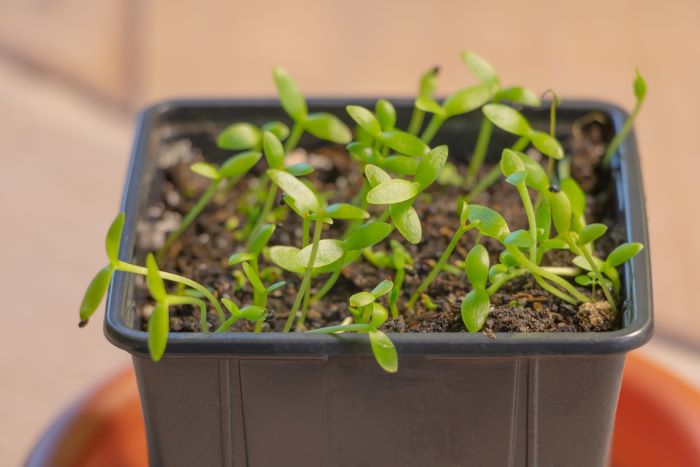
Growing dragon fruit from seeds is a bit more challenging compared to propagating from cuttings, but it can be a rewarding experience. So here’s how to do it.
1. You can use dragon fruit seeds (pitaya seeds) from a mature fruit. Simply scoop the seeds from a ripe dragon fruit and wash them thoroughly to remove any fruit pulp.
2. Dry the seeds for a day or two on a paper towel, as this helps prevent rotting.
3. Use a well-draining potting mix suitable for cacti and succulents like this one. You can also create a mix of sand and potting soil for better drainage.
4. Plant the dragon fruit seeds about 1/4 inch deep in the growing medium. You can plant multiple dragon fruit seeds in the same container.
5. Water the soil thoroughly after planting, and then keep the soil consistently moist but not waterlogged. Use a spray bottle to mist the soil regularly to maintain moisture. Cover the container with plastic wrap to create a mini greenhouse effect, which helps retain moisture.
6. Place the container in a warm, well-lit location with indirect sunlight. Maintain a temperature of around 75-80°F (24-27°C) for optimal germination. You might want to use a heat mat for this purpose.
7. Dragon fruit seeds can take anywhere from a few weeks to a few months to germinate. So be patient and continue to maintain the moisture and temperature conditions.
8. Once the seedlings have grown a few inches and have several true leaves, you can transplant them to larger pots or directly into your garden. Choose a warm sunny location with well-draining soil, preferably on mounded soil to make sure the soil drains well.
9. As mentioned earlier, dragon fruit plants grown from seed can take several years, (as many as 7 years) before they start to bear fruit. Even then, the results may not be consistent with the fruit you took seed from.
Growing dragon fruit from seeds can be a longer and more uncertain process compared to cuttings, but it can be a satisfying way to start your own unique dragon fruit varieties. And with the right care and attention, your dragon fruit seeds can develop into healthy, fruit-bearing plants.
How to Propagate Dragon Fruit from Cuttings
You can purchase a dragon fruit plant from your local nursery or if you have a friend or neighbour with a dragon fruit plant you can propagate your own.
To propagate dragon fruit from cuttings, start by selecting a healthy stem from a mature plant. Cut the stem into sections, making sure each section has at least 1 or 2 nodes. Allow the stem cuttings to dry for a few days to prevent rotting.
After the cuttings have dried, you can either dip them in rooting hormone to encourage root development or skip this step if you prefer a more natural approach.
Prepare a pot or container with a well-draining soil mix or cactus mix. Make sure the pot has drainage holes to prevent waterlogging.
Insert the cuttings into the soil, burying them about 1-2 inches deep. Space the cuttings apart to allow room for growth.
Water the cuttings thoroughly after planting, ensuring the soil is evenly moist but not overly wet. After the initial watering, be careful not to overwater the cuttings, as it can lead to rotting.
Place the potted dragon fruit cuttings in a warm, bright location with indirect sunlight. Avoid exposing them to direct sunlight, as it can scorch the cuttings.
Keep up a consistent level of moisture in the soil by watering when the top inch of soil feels dry. Just be mindful not to overwater, as dragon fruit cuttings are prone to rot if kept too wet.
After a few weeks (sometimes longer), you should start to see signs of new growth, such as the emergence of small pinkish or green shoots. This indicates successful rooting.
Continue to care for the new plants by providing them with adequate sunlight, warmth, and regular watering. Gradually increase their exposure to direct sunlight as they acclimate.
Once the cuttings have established a strong root system and grown several inches in height, you can transplant them into larger pots or into the ground in a mounded hill to help with soil drainage.
Be patient, as dragon fruit propagation can take several weeks to months for successful root development and growth. It typically takes about 2-3 years for dragon fruit plants to begin producing fruits, so be patient and enjoy the process.
Dragon Fruit Cactus Care Maintenance
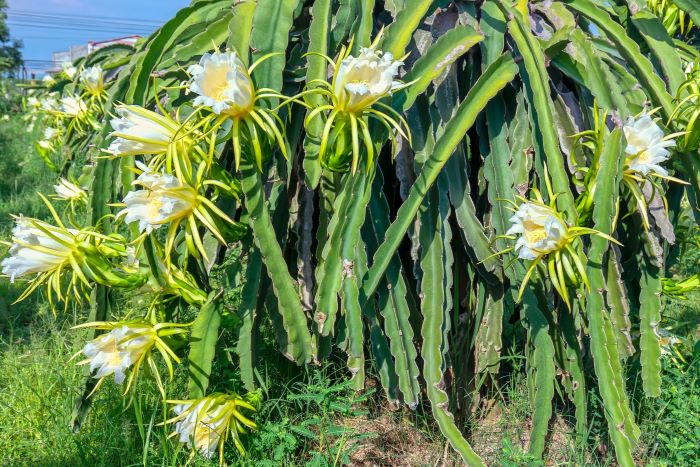
Once your dragon fruit plant has been planted in the ground or a container, there are a few tips to help them really thrive. The right care and maintenance will give you a healthy and productive dragon fruit cacti.
Staking and Trellising
You will need to stake or trellis your dragon fruit plants to provide support as they grow. This will prevent the fruits from touching the ground and protect them from rotting.
As we learned earlier, dragon fruit plants are climbers and can grow quite large. Without proper support, their branches can become tangled and the fruits can touch the ground. This can lead to fruit rotting, as the damp ground provides a perfect environment for fungi and bacteria to grow. To prevent this, you should stake or trellis your dragon fruit plants.
Dragon fruit plants can grow very tall and heavy, so it’s important to use a strong support system. Consider using concrete posts, metal or wooden stakes or a trellis made of a durable material, such as bamboo or wire mesh.
Place the post, stake or trellis near the base of the dragon fruit plant. If using a stake, insert it about 1 to 2 feet deep into the ground, ensuring it is securely anchored. If using a trellis, attach it to a solid structure or place it firmly into the ground.
Gently guide the dragon fruit branches towards the stake or trellis and use soft ties, such as garden twine or plant clips, to secure them loosely. Avoid tying too tightly, as this can restrict the growth and damage the plants.
As the dragon fruit plant continues to grow, periodically check the branches and tie them to the support system. This will ensure that the fruits remain off the ground, reducing the risk of rot.
Dragon fruit plants can produce multiple branches, and excessive growth can make it difficult to manage and support them. You can prune any unnecessary branches to maintain a manageable shape and promote air circulation, which can reduce the risk of disease.
Traditionally, a leader stem is trained up the trellis or post with side branches removed. Then the dragon fruit branches are trained over the top of the support so the branches hang down which is required for the development of flowers and fruit set.
Pruning
You can regularly prune your dragon fruit plants to remove any dead or diseased branches. Pruning will also promote airflow and sunlight penetration, resulting in healthier plants and better fruit production.
Pruning should be done during the growing season when the dragon fruit cacti is actively producing new shoots and branches.
To prune your dragon fruit plant, start by inspecting the plant for any dead, damaged, or diseased branches. These branches are often discolored, weak, or brittle. Use sharp, clean pruning shears to cut off these branches at their base, making sure to remove them entirely.
Look for any overcrowded or crossing branches that could impede airflow and sunlight. These branches can restrict plant growth and increase the risk of disease. Carefully prune these branches by cutting them back to the main stem or a healthy lateral branch.
If your dragon fruit plant has become too tall or bushy, you may need to selectively prune some of its branches to maintain a manageable size. Remove any excess branches that are causing overcrowding or limiting sunlight exposure to neighboring branches.
Pay attention to the balance of branches throughout the plant. Ideally, you want an open and balanced structure, which allows for good airflow and uniform light distribution. Trim branches that may be growing too vigorously or overtaking others to create a more even canopy.
Weeding and Mulching
Keep the area around your dragon fruit plants weed-free to prevent competition for nutrients and water. Regularly remove any weeds that may appear around the plant.
Weeds can compete with dragon fruit plants for essential resources like nutrients and water, affecting their growth and productivity.
Mulching around your dragon fruit plant, an inch or so away from the base of the plant, will not only help keep weeds at bay but will also help maintain soil moisture.
I prefer to use organic mulches such as straw, shredded leaves, wood chips and compost. Organic mulch will also help feed the soil and provide nutrients as it breaks down.
You can mulch 3-4 inches thick and ideally, extend the mulch area beyond the drip line of the dragon fruit plant. The drip line is the outermost circumference of the plant’s branches. This will help to provide a larger area for moisture retention and weed suppression.
Hand-Pollinating
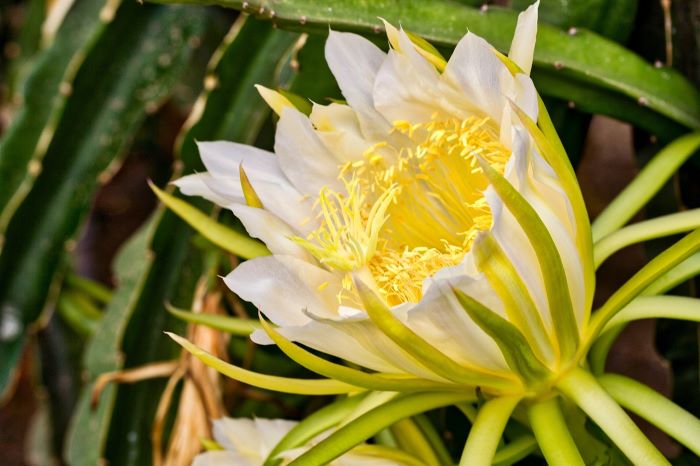
Many varieties of dragon fruit are self-pollinating but there are some varieties that require you to have another plant nearby for successful pollination. In any case, dragon fruit trees mostly rely on pollinators, such bats, moths, bees and other insects, for fruit set.
However, the flowers are only open for a limited time (up to 2 days), and if you are growing in a backyard, your pollinators may be limited. If this is the case, you can hand-pollinate the flowers to ensure a fruit crop.
To do this, you can gently transfer pollen from the stamen to the stigma using a small paint brush or cotton swab. Here’s how.
Dragon fruit flowers bloom overnight and may only last for one night or up to 2 days. Therefore, you will need to identify the newly opened flowers in the morning.
Inside the dragon fruit flower, you will find several stamens (male reproductive structures) surrounding the central stigma (female reproductive structure). The stamens contain pollen, while the stigma receives the pollen to initiate fertilization.
The best time to collect pollen is around mid-morning or early afternoon. At this time, the pollen is mature and ready for transfer.
Gently remove a stamen from a fully bloomed flower. The stamen will have a yellowish or white, powdery appearance, indicating that it contains mature pollen.
Carefully touch the brush or cotton swab to the pollen grains, collecting them on the brush tip. Then, transfer the collected pollen to the stigma. Make sure to gently brush the stigma with the pollen to ensure effective pollination.
Repeat the process of collecting pollen and transferring it to the stigmas of other open flowers. This will increase the chances of successful fruit set.
To prevent accidental pollination by insects, you can cover the flowers with a mesh bag or cloth after hand-pollinating. This will keep the transferred pollen intact and ensure that it reaches the stigma.
If the pollination process was successful, you should notice the flowers forming fruit a few weeks after pollination.
Dragon Fruit Plant Pests and Diseases
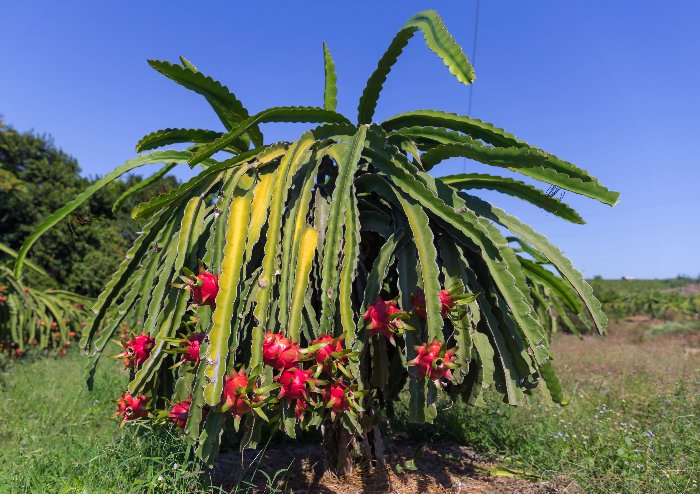
Pests
Dragon fruit cactus plants are relatively pest-resistant. However, they can occasionally be affected by common garden pests such as aphids, scale insects, and mealybugs.
I suggest regularly inspecting your plants and taking appropriate measures if you notice any signs of infestation. I would start with hosing the pest off the dragon fruit plant which is usually enough to dislodge them.
However, if the infestation becomes severe, you can use organic insecticidal soaps or neem oil. These are effective in controlling aphids, scale insects, and mealybugs without harming beneficial insects.
You can encourage beneficial insects like ladybugs, lacewings, and spiders that eat these pests to make your garden their home. You can do this by planting companion plants like flowering herbs and plants can help attract natural predators.
Diseases
Common diseases that can affect dragon fruit plants include fungal infections, root rot, and stem rot. To prevent diseases, ensure proper soil drainage and avoid overwatering. If necessary, you can use organic fungicides to control fungal infections.
Viral infections such as dragon fruit yellow blotch virus and dragon fruit mealybug wilt-associated virus can also be a concern for dragon fruit plants.
To prevent viral infections, avoid planting infected cuttings and practice good sanitation, such as cleaning tools used for pruning and disinfecting pots.
Related: 5 Reasons Dragon Fruit Plant Is Turning Yellow
Harvesting Dragon Fruit
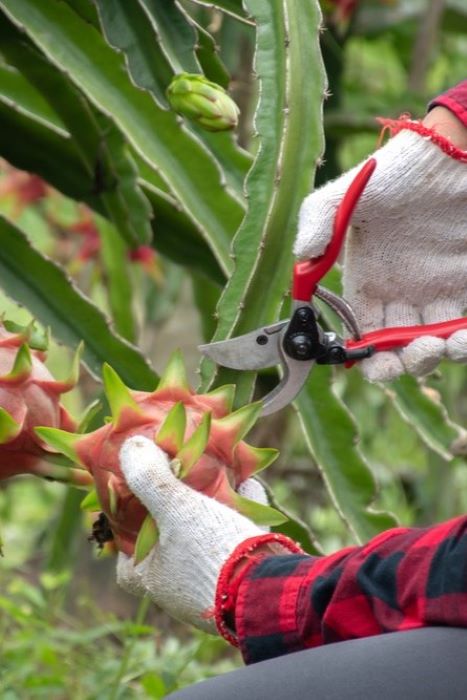
Dragon fruit is ready to harvest when it has fully ripened. From flower formation until the dragon fruit is ripe takes about 30 days. At this point, you can leave the fruit on the plant for up to 10-15 days but you will risk losing the fruit to birds!
To confirm your dragon fruit is ripe, you can check the texture and color of the fruit.
The dragon fruit should have a slightly soft texture when gently pressed, indicating that it is ripe and ready to be harvested.
The fruit should also have a vibrant skin color. Depending on the variety, this could be a deep pink, bright red, or even yellow. The skin of the fruit should appear smooth and, in some cases, have scales or spiky protrusions.
To harvest the dragon fruit, simply twist it off the plant or cut it with pruning shears.
Dragon Fruit Storage Tips
Ripe dragon fruit can be stored in the refrigerator where it will keep fresh for up to one week. Wrapping the fruit in a paper towel or placing it in a perforated plastic bag can help absorb excess moisture and prevent mold growth.
Once cut, any leftover dragon fruit should be placed in an airtight container and stored in the refrigerator, where it can last for up to three days.
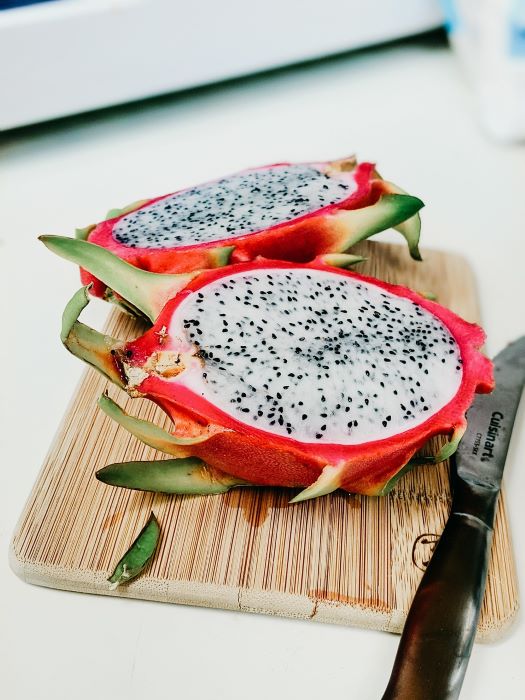
If you have harvested slightly unripe fruit, you can store it in a cool and dry place (not the refrigerator) where it will continue to develop its color but it will not develop additional flavor. I leave mine out on the dining room table and then once they look ready they either get eaten or stored in the refrigerator.
Dragon fruit can also be cut up and frozen through the texture will be mushy and the taste not as good. You can still use them to make delicious smoothies. To freeze dragon fruit, cut into bite-sized cubes, and freeze them separately for a few hours before placing them in freezer bags. Use frozen dragon fruit within 6 months.
Dragon Fruit Plant Varieties
There are several different varieties of dragon fruit available, each with its own unique characteristics and flavor profiles. Some popular varieties include the white-fleshed Dragon Fruit (Hylocereus undatus), the red-fleshed Dragon Fruit (Hylocereus costaricensis), and the yellow-fleshed Dragon Fruit (Hylocereus megalanthus).
The white-fleshed dragon fruit, also known as Pitaya blanca, is the most common variety found in supermarkets. It has a vibrant red or pink exterior with white flesh speckled with tiny black seeds. The flavor profile of the white-fleshed Dragon Fruit is often described as mild and subtly sweet, with hints of kiwi and pear.
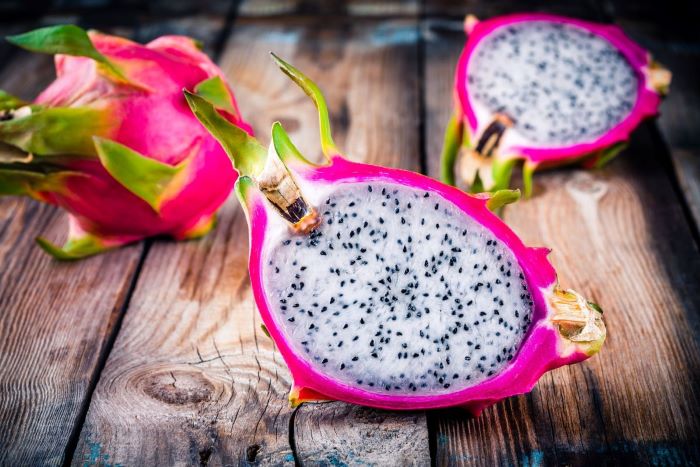
The red-fleshed dragon fruit, sometimes called Pitaya roja or Pitaya purpura, has a stunning red or magenta exterior with vibrant red flesh. Its flavor is typically sweeter and has a slight berry-like taste, reminiscent of watermelon.
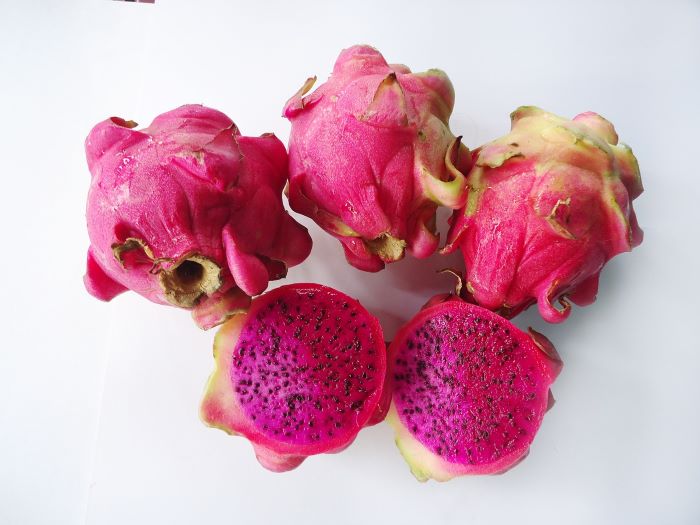
The yellow dragon fruit, also known as Pitaya amarillo, has a bright yellow exterior and pale white flesh. It has a sweeter flavor compared to the white-fleshed variety, with hints of pineapple and citrus.
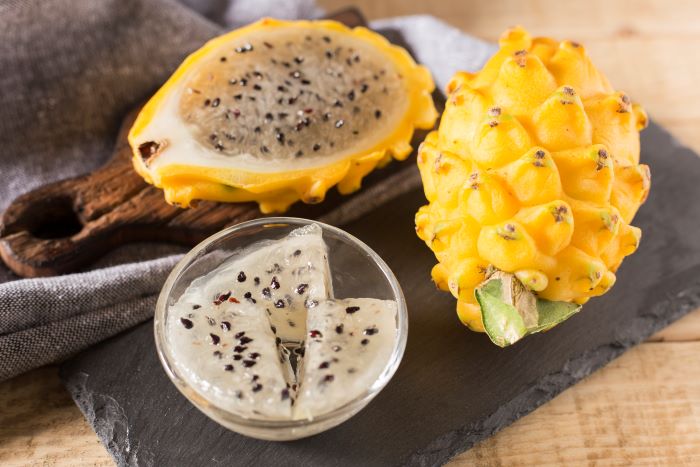
Related:
- Tree Tomato: How to Grow Tamarillo Trees and Eat The Fruit
- Tree Tomato: Tamarillo Tree Leaves Turning Yellow (Causes And Solutions)
- How Many Pineapples Grow on One Plant? Answered!
- Pepino Melon: How To Grow The Plant And Eat The Fruit
- How to Grow a Mango Tree: Planting, Caring and Harvesting
- How to Grow Chayote Squash (Choko) – the easy way!
